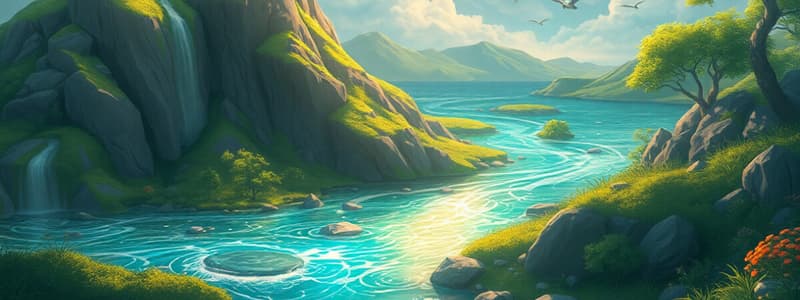Podcast
Questions and Answers
What collective term describes the processes where water changes from a liquid state on the Earth's surface to a gaseous state in the atmosphere?
What collective term describes the processes where water changes from a liquid state on the Earth's surface to a gaseous state in the atmosphere?
- Evapotranspiration (correct)
- Infiltration
- Precipitation
- Condensation
Which process primarily drives the movement of water from the roots to the leaves in plants during transpiration?
Which process primarily drives the movement of water from the roots to the leaves in plants during transpiration?
- Positive water pressure in the roots
- Active transport in the xylem
- Negative water pressure in the leaves (correct)
- Capillary action in the stem
What is the main function of stomata in the process of transpiration?
What is the main function of stomata in the process of transpiration?
- To store excess nutrients for the plant
- To facilitate gas exchange and water vapor release (correct)
- To conduct photosynthesis within the leaf
- To absorb water from the atmosphere
Which environmental factor is described as the primary energy source driving evaporation in the water cycle?
Which environmental factor is described as the primary energy source driving evaporation in the water cycle?
How does transpiration differ fundamentally from evaporation in the water cycle?
How does transpiration differ fundamentally from evaporation in the water cycle?
Which of the following statements accurately describes the water cycle?
Which of the following statements accurately describes the water cycle?
What is the primary energy source that drives the processes of the water cycle?
What is the primary energy source that drives the processes of the water cycle?
During evaporation in the water cycle, what change of state does water undergo?
During evaporation in the water cycle, what change of state does water undergo?
What is the role of atmospheric dust particles in the process of condensation?
What is the role of atmospheric dust particles in the process of condensation?
Which of the following is an example of precipitation in the water cycle?
Which of the following is an example of precipitation in the water cycle?
Flashcards
Evaporation
Evaporation
The process where liquid water changes into water vapor (a gas) due to the heat from the sun.
Condensation
Condensation
The process where water vapor in the atmosphere cools down and changes back into liquid water, forming clouds.
Precipitation
Precipitation
Any form of water that falls from the atmosphere to the Earth's surface, like rain, snow, sleet or hail.
Transpiration
Transpiration
Signup and view all the flashcards
Water Cycle
Water Cycle
Signup and view all the flashcards
What is transpiration?
What is transpiration?
Signup and view all the flashcards
What is evaporation?
What is evaporation?
Signup and view all the flashcards
What are stomata?
What are stomata?
Signup and view all the flashcards
How do plants contribute to the water cycle?
How do plants contribute to the water cycle?
Signup and view all the flashcards
What is evapotranspiration?
What is evapotranspiration?
Signup and view all the flashcards
Study Notes
The Water Cycle and Plant Contributions
-
The water cycle, also known as the hydrologic cycle, is the continuous movement of water through the atmosphere and Earth's surface. It's a repeating process with no beginning or end. It's not a circle; water follows various pathways.
-
The driving force of the water cycle is solar heat.
Key Processes in the Water Cycle
-
Evaporation: Liquid water transforms into water vapor. This happens from bodies of water and the surface; it also happens from plants (transpiration.)
-
Transpiration: Plants draw up water from the ground and release it as water vapor through tiny openings called stomata on their leaves. This contributes significantly to atmospheric water vapor.
-
Condensation: Water vapor cools and changes back to liquid water, forming clouds.
-
Precipitation: Condensed water falls back to Earth as rain, snow, sleet, or hail.
Plant Role in the Water Cycle
-
Plants play a vital role, contributing approximately 10% of the water vapor in the atmosphere.
-
Transpiration: Plants absorb water through their roots, transport it to the leaves, and release it as water vapor through stomata. This is critical for nutrient uptake and maintaining internal pressure, much like a straw.
-
Stomata are microscopic openings on the underside of leaves, responsible for gas exchange and transpiration.
-
Transpiration also cools the plant and helps to move water and nutrients throughout the plant.
-
Plants uptake water to carry out photosynthesis, the process where carbon dioxide and water, with energy from the sun, are used to produce sugars for plant food.
Evaporation in the Water Cycle
-
- Evaporation is the process of liquid water changing state to gas(water vapor).
-
It's driven by solar energy, which warms the water surface.
-
Evaporation rates are affected by temperature and amount of water available.
-
Evaporation occurs in various ways; from oceans and other bodies of water, to plants, and even from open water in everyday life.
-
It is important to recognize how wind plays a role in this process; the push of air can cause evaporation.
-
Animals also evaporate water through sweat glands or breathing, as seen when dogs pant.
Studying That Suits You
Use AI to generate personalized quizzes and flashcards to suit your learning preferences.




